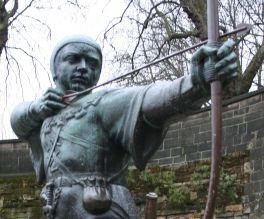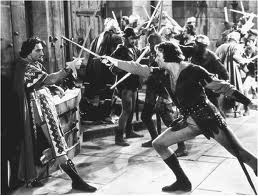A new play by David Farr, called The Heart of Robin Hood, is just about to open at the Royal Shakespeare Theatre.
The legend of Robin Hood is a great subject for the RSC as it was obviously a story Shakespeare knew well. It comes to his mind when he’s looking back to a more comforting past. The scene in Justice Shallow’s orchard, in Henry IV part 2, is one of those. A group of old men sit around reminiscing about the good old days. All through the scene, one of them, Silence, sings snatches from old songs, one of which is “of Robin Hood, Scarlet and John”. That’s his last line before the news arrives that the old King is dead and young Prince Hal is now to be crowned. While plans are made celebrating the dawn of a new era, Silence is carried offstage to his bed.
At other times Shakespeare introduces the world of Robin Hood to the stage. No sooner do they meet him than the outlaws in The Two Gentlemen of Verona adopt Valentine as their leader:
By the bare scalp of Robin Hood’s fat friar,
This fellow were a king for our wild faction!
And in As You Like It two worlds collide. The old Duke has been banished by his usurping brother, and has fled:
They say he is already in the forest of Arden, and a many merry men with him; and there they live like the old Robin Hood of England. They say many young gentlemen flock to him every day, and fleet the time carelessly, as they did in the golden world.
Pretty shepherds and shepherdesses, straight from the fashionable world of pastoral romance, fall in love and share the space with the outcasts, but the forest isn’t as idyllic as the pastoral poets suggested: there’s cold weather, fierce animals, and the threat of interference from the outside world.
By Shakespeare’s time the legend was already old. Nobody is clear when or where it first appeared. Although Robin is now firmly associated with Sherwood Forest and the Nottingham area, he’s also been linked with other places, even the village of Loxley, near Stratford-upon-Avon where in 1193 the Lord of Loxley Manor was Robert Fitz-Odo, a noblemen of Norman descent who mysteriously lost his land.
The story even finds its way into Shakespeare’s life: one of the most persistent myths is that he poached deer from Sir Thomas Lucy, whose threat of prosecution forced him to flee, not into the forest, but to London. This story was adopted by the Shakespeare Memorial Theatre in the late nineteenth and early twentieth centuries. In every performance of As You Like It (and there were many) a stuffed stag from Charlecote Park was brought on stage. In between performances the animal was hung high up in the theatre’s Picture Gallery for visitors to admire.
There have been too many versions of this legend to mention, but there are lots of sites to check out if you’re interested. Allen W Wright’s website is full of illustrations and links, and this site is full of information about the Robin Hood legend. The article on Wikipedia is also extremely full.
The “Robbed from the rich, gave to the poor” line which makes him everybody’s favourite outlaw is a fairly recent addition, though the story always shows him standing up to authority. Russell Crowe’s 2010 film seems to have taken itself very seriously: “Robin and his band of marauders confront corruption in a local village and lead an uprising against the crown that will forever alter the balance of world power”.
And the RSC’s production promises to be “darker than you’re used to”.
The notorious Robin Hood and his band of outlaws steal from the rich, creating a fearsome reputation amongst those who dare to travel through the mighty forest of sherwood. But they do not share their spoils with the poor and are unloved by the people, who must also pay unfair taxes to the evil Prince John as he plots to steal his brother’s crown. In this time of chaos and fear, it is down to Marion to boldly protect the poor and convince Robin that he must listen to his heart if they are to save the country.
This certainly sounds like a fable for our times. The production begins previewing on 18 November and promises to be spectacular. I can’t wait!




Thanks for blogging about one of my favourite subjects, Robin Hood. You may remember I commented on your fourth blog about A Midsummer Night’s Dream, where I made a reference to Robert Fitz Odo as one possible real life source for the legend. It is worth noting that there is currently only one village named Loxley in England and that is south of the river between Stratford-upon-Avon and Wellesbourne. However there may have been earlier deserted villages (what archaeologists call D.M.V’s) elsewhere.
Robin was clearly a Midland woodland spirit.
Through Shakespeare’s printer friend and fellow Stratfordian Richard Field, Shakespeare had access to at least one work printed in 1492 circa by Wynkyn de Worde of The Sign of the Sun in Fleet Street. Indeed for those not familar with
Shakespeares sources Shakespeare’s own copy of Holinshed’s Chronicles now held in the Folger Library in New York can see his annotations against Robin Hood and Little John on the 2nd page . The cover of his copy of the Chronicles is autographed with
more than 5 ‘WS’ initials no doubt the result of trying to get the ink to flow. On the first page of the ‘Geste of Robin Hood’ (Cambridge copy) we see the same ‘WS’ is repeated. The origin of the Cambridge copy was the More family in Blackfriars a place where Shakespeare stayed when the plague was raging. So we at least know that Shakespeare had researched the subject. On the final page Shakespeare left us a clue in his own hand “When stormy clouds of strife be past, Shall quiet calms appear and with good advice mark this in mind you shall the master (Robynhode) strange here find” Entered in the Stationer’s Register in 1594 we find ‘The pleasant comedy of Robin Hood and Little John”. No doubt this entry refers to a lost Robin Hood/Little John play by William Shakespeare though it was not assigned, witnessed or pledged.
I am certain this is the work of Mr WS. David Greenwood
Shakespeare’s interest in the Gest of Robin Hood will have been in the impoverished knight who was Sir Richard Vernon of the Lee, one of the principle characters in “Henry IV.” Sir Richard Vernon joined with rebel forces in the Battle of Shrewsbury (1403) and was hanged, drawn and quartered on the orders of the Henry IV., his body parts were distributed throughout the kingdom. The character called Silence asked for news of Robin Hood, Scarlet and John and presumably the audience will have known about the trio’s circumstances at the time otherwise the line will have been lost on them.
http://robinhood-loxley.weebly.com/robin-hood-in-history.html
With best regards, Graham.
A pardon for Robin Hood has been found, please see here
http://robinhood-loxley.weebly.com
With best regards, Graham.